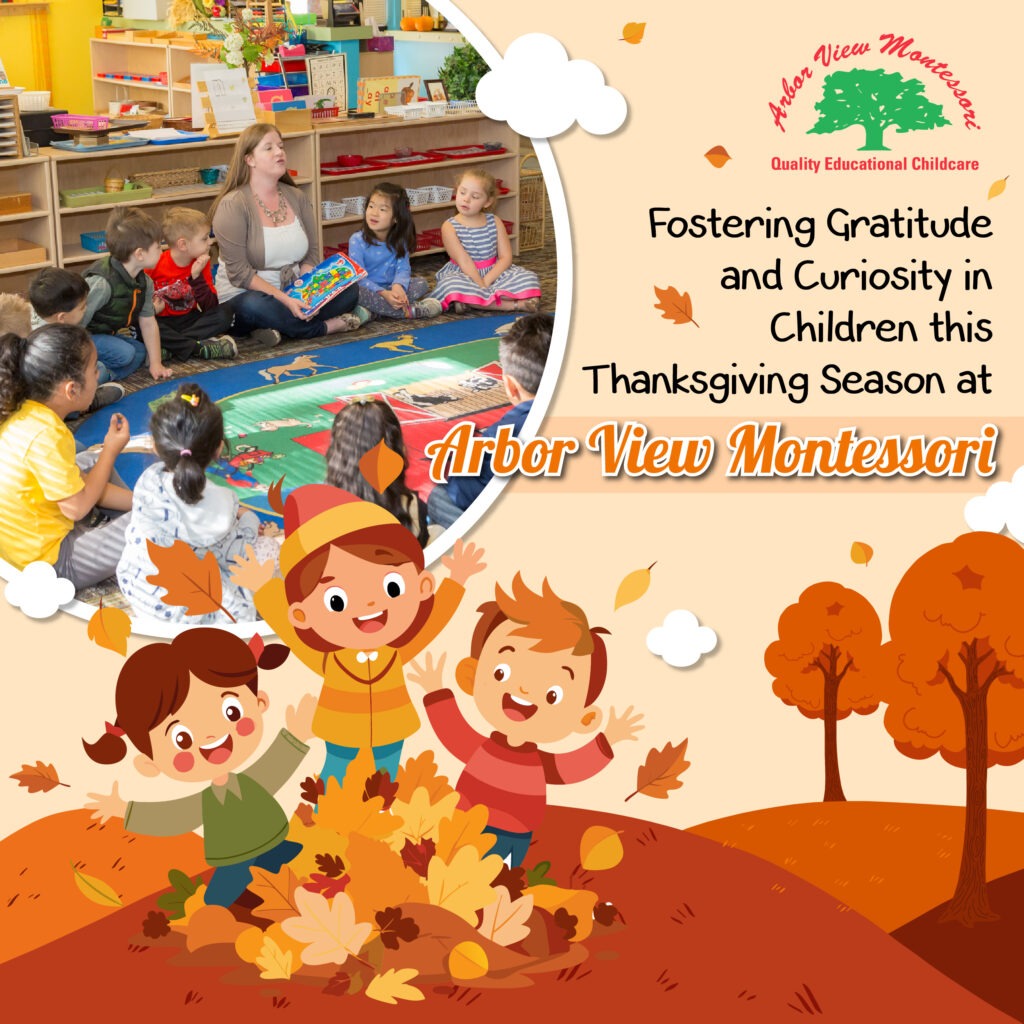
Introduction:
As Thanksgiving approaches, it’s the perfect time for families to reflect on the values of gratitude, curiosity, and community involvement. These core principles align beautifully with the Montessori philosophy, which emphasizes respect, appreciation, and wonder for the world around us. At Arbor View Montessori, we encourage children to express gratitude not only during the holiday season but year-round. This blog will explore how Montessori education fosters these values and offer practical ways for parents to nurture gratitude and curiosity at home.
Gratitude in Montessori Education:
Gratitude in the Montessori classroom is not just taught but lived. Children learn to appreciate their environment, their peers, and their learning experiences through daily routines and interactions. Montessori philosophy encourages self-reflection and respect for others, which naturally cultivates gratitude. Here are some ways Arbor View Montessori instills this value:
- Gratitude Circles:
In the weeks leading up to Thanksgiving, classrooms may hold “Gratitude Circles” where children share what they are thankful for. This practice teaches children to articulate their appreciation and listen to others with respect. - Acts of Kindness:
Helping others is an essential part of expressing gratitude. Montessori students participate in community service projects or help their peers in daily classroom tasks. These activities help children understand the importance of giving back and appreciating the support they receive from others. - Gratitude Journals:
For older children, writing about what they are thankful for each day helps solidify the practice of mindfulness. Montessori classrooms often encourage journaling to reflect on daily experiences, fostering an ongoing sense of appreciation.
Nurturing Curiosity through Montessori Education:
Curiosity is a natural driver of learning, and Montessori education harnesses this by allowing children to explore subjects that interest them. At Arbor View Montessori, we encourage students to ask questions, investigate their environment, and find joy in discovery. This process of learning through inquiry nurtures a lifelong love for learning.
- Nature Walks and Outdoor Learning:
Fall is a perfect time to explore the beauty of nature. Montessori educators often take students on nature walks, encouraging them to observe the changes in the seasons, collect leaves, and learn about the environment. These activities teach children to appreciate the natural world, sparking curiosity about how nature works. - Thanksgiving-Themed Projects:
Thanksgiving offers a chance to connect history, culture, and science. Children might explore the origins of the holiday, learn about the harvest, or create nature-inspired crafts like leaf collages or gratitude trees. These hands-on projects engage their curiosity and creativity. - Freedom to Explore:
Montessori’s child-led approach means that children are free to explore their interests in depth. Whether it’s learning about the history of Thanksgiving or understanding the science behind fall leaves, Montessori classrooms give children the tools and autonomy to pursue their curiosity.
Practical Ways Parents Can Nurture Gratitude and Curiosity at Home:
Montessori education doesn’t end in the classroom. Parents can foster gratitude and curiosity at home through simple, everyday practices. Here are some ideas to incorporate Montessori principles into your family’s Thanksgiving traditions:
- Create a Family Gratitude Tree:
Just as children create gratitude trees at school, you can bring this activity home. Have your child write down what they’re thankful for on paper leaves and attach them to a tree made from branches. This daily reminder encourages both gratitude and reflection. - Thanksgiving Community Involvement:
Engage your child in acts of service. Volunteer as a family at a food bank, or encourage your child to donate some of their toys or clothes to those in need. Discuss how giving to others can enrich our own lives. - Ask Open-Ended Questions:
Foster your child’s curiosity by asking questions that encourage exploration, such as “Why do you think the leaves change color in the fall?” or “What do you think the Pilgrims were most thankful for?” Let your child investigate the answers through books, nature, or online resources. - Mindful Gratitude Practices:
Set aside time each day during the Thanksgiving season to share what each family member is thankful for. This could be at the dinner table or during a quiet moment before bed. This practice helps reinforce the importance of gratitude in daily life.
Conclusion:
At Arbor View Montessori, we believe that Thanksgiving is more than a holiday; it’s an opportunity to instill lifelong values of gratitude, curiosity, and respect. By incorporating Montessori principles both at school and at home, parents can help their children develop a deeper appreciation for the world around them. As we move through this Thanksgiving season, let’s reflect on all that we are thankful for and continue to foster a sense of wonder and learning in our children.
